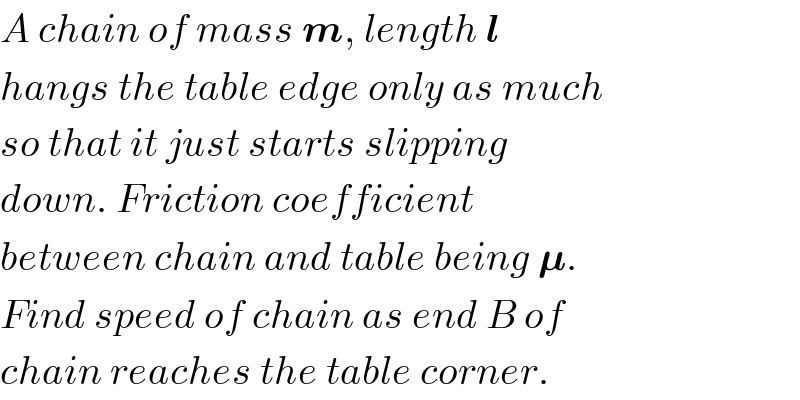
Question and Answers Forum
Question Number 40551 by ajfour last updated on 24/Jul/18

Commented by ajfour last updated on 24/Jul/18

Commented by tanmay.chaudhury50@gmail.com last updated on 24/Jul/18

Commented by ajfour last updated on 24/Jul/18

Commented by tanmay.chaudhury50@gmail.com last updated on 24/Jul/18

Commented by tanmay.chaudhury50@gmail.com last updated on 24/Jul/18

Answered by MrW3 last updated on 24/Jul/18
![length of hanging part=y ρ=(m/l) y_0 ρg=μ(l−y_0 )ρg ⇒y_0 =(μ/(1+μ)) l yρg−μ(l−y)ρg=ma=lρ v(dv/dy) y−μ(l−y)=(l/g) v(dv/dy) ∫_y_0 ^l [(1+μ)y−μl]dy=(l/g) ∫_0 ^v vdv [(1+μ)(y^2 /2)−μly]_y_0 ^l =(l/g) (v^2 /2) (1/2)(1+μ)(l^2 −y_0 ^2 )−μl(l−y_0 )=(l/g) (v^2 /2) [(1+μ)(l+y_0 )−2μl](l−y_0 )=(l/g) v^2 [(1+μ)(1+(μ/(1+μ)))−2μ](1−(μ/(1+μ)))lg=v^2 ((lg)/(1+μ))=v^2 ⇒v=(√((lg)/(1+μ)))](Q40555.png)
Commented by MrW3 last updated on 24/Jul/18

Commented by ajfour last updated on 24/Jul/18

Commented by MrW3 last updated on 24/Jul/18

